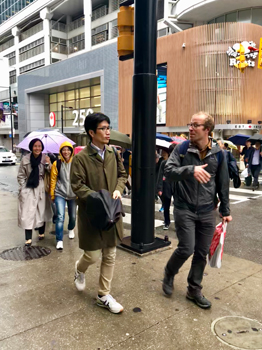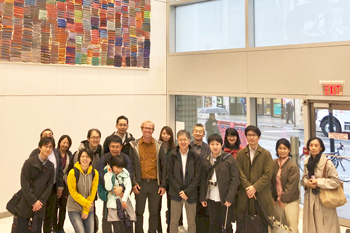Japanese delegation visits St. Michael’s for a first-hand look at care for vulnerable populations

By Michael Oliveira

Dr. Gary Bloch (right) leads Dr. Mitsuhiko Funakoshi and the rest of the delegation on a tour of clinics and sites around St. Michael’s Hospital.
Twice last year, St. Michael Hospital’s Dr. Gary Bloch was invited to Tokyo to speak about the development of his poverty intervention tool and how doctors’ and health teams’ support for vulnerable populations can have a profound effect on their health.
This week, a 17-member delegation of Japanese health-care professionals visited Toronto to see first-hand how Dr. Bloch and the St. Michael’s Family Health Team work.
“We have been engaged in an exciting dialogue with our colleagues in Japan,” said Dr. Bloch.
“While their context is somewhat different to ours, it is clear that they view our experience in clinical-care innovations, education, research, and advocacy interventions into social health as unique, exciting, and worthy of study and replication.”
The delegation from Min-Iren – an organization consisting of almost 1,800 health institutions including more than 140 hospitals – was interested in how targeting poverty in a health-care setting can help at a micro and macro level, said Dr. Mitsuhiko Funakoshi of the Chidoribashi General Hospital, who organized the trip to Toronto.
“In both our countries the rate of poverty is increasing,” Dr. Funakoshi said through a translator. “There are many cases where we find this kind of problem with patients in a consultation room. But not all doctors are interested in this issue.
“So in our hospitals, the kind of support we provide to the patients is also a problem. Learning how we could support patients, and what kind of supports we can provide, were questions.”
Dr. Bloch’s poverty intervention tool encourages doctors to talk to their patients about their income security and consider how poverty is a risk factor for serious health conditions including cancer, diabetes, cardiovascular disease and mental illness.

The group poses for a photo after a tour of the Upstream Lab Research Institute.
Interventions can include providing patients with information about government benefits or resources that could improve their financial health and ultimately prevent disease.
The Japanese delegation also learned about the Family Health Team model at St. Michael’s and its unique programs focused on addressing the social determinants of health, including income security health promotion, health justice, racism and literacy.
Tours included a visit to the Upstream Lab Research Institute, Family Health Team clinics, and downtown areas where vulnerable populations face pressing health challenges, including Moss Park.
”The opportunity to tour our programs and community with this engaged delegation allowed me to appreciate the work we do, and our context, through new eyes,” said Dr. Bloch.
“It was truly a pleasure to take a step back and appreciate how and where we work.”
About St. Michael’s Hospital
St. Michael’s Hospital provides compassionate care to all who enter its doors. The hospital also provides outstanding medical education to future health care professionals in more than 29 academic disciplines. Critical care and trauma, heart disease, neurosurgery, diabetes, cancer care, care of the homeless and global health are among the Hospital’s recognized areas of expertise. Through the Keenan Research Centre and the Li Ka Shing International Healthcare Education Centre, which make up the Li Ka Shing Knowledge Institute, research and education at St. Michael’s Hospital are recognized and make an impact around the world. Founded in 1892, the hospital is fully affiliated with the University of Toronto.
St. Michael’s Hospital with Providence Healthcare and St. Joseph’s Health Centre now operate under one corporate entity as of August 1, 2017. United, the three organizations serve patients, residents and clients across the full spectrum of care, spanning primary care, secondary community care, tertiary and quaternary care services to post-acute through rehabilitation, palliative care and long-term care, while investing in world-class research and education.
